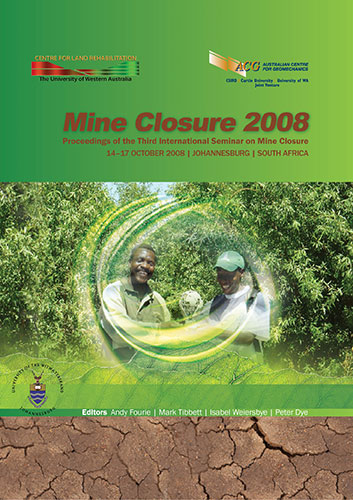Comprehensive Planning for Closure of Mining Activities at Early Stages and its Impacts on the Business Plan and Mine Development Operations

|
Authors: Flores, IP; Smith, KW; Getahun, A; Pérez, IP Paper is not available for download Contact Us |
DOI https://doi.org/10.36487/ACG_repo/852_20
Cite As:
Flores, IP, Smith, KW, Getahun, A & Pérez, IP 2008, 'Comprehensive Planning for Closure of Mining Activities at Early Stages and its Impacts on the Business Plan and Mine Development Operations', in AB Fourie, M Tibbett, I Weiersbye & P Dye (eds), Mine Closure 2008: Proceedings of the Third International Seminar on Mine Closure, Australian Centre for Geomechanics, Perth, pp. 215-221, https://doi.org/10.36487/ACG_repo/852_20
Abstract:
Experience in Chile has shown that closure is sometimes regarded as an activity which is not planned early in the life cycle of a mine. In contrast, while a similar situation existed historically in the United States, the currently promulgated state-specific regulatory requirements for financial surety forces mining companies to look at closure earlier in the life cycle assessment process. Thus, lack of mine closure planning is more probable in countries or states where the regulations on closure are vague or non-existent. This can result in a short-term analysis of closure, with often the bare minimum provisioned for, or allocated to, solely meeting permit requirements, and not on planning closure as an integral part of the project’s lifecycle embedded within the overall management of the business. Some multinational mining companies regard the closure stage as a continual process that starts at the beginning of the mine planning’s life. Consequently, as long as mining companies understand that the resources, efforts and costs associated with early planning are directly linked to ultimate cost savings, it will be possible to achieve successful closures with fewer surprises to shareholders. An example of how comprehensive planning early in the life of mine planning, maintained along the entire mine lifecycle can condition investment decisions on the business-side, is provided in this paper. Key actions to take into consideration, based on the description of key aspects of the planning, and how those actions can have positive impacts on the business, are proposed. An example of a smelter in Chile, where the key issues of closure planning are identified early within the lifecycle management, is given. By tracking these issues at each stage of the project lifecycle, understanding improves and information about the magnitude of potential issues and associated costs is obtained. It then becomes possible to weigh up the risk and magnitude of closure options, and consequently produce more accurate cost estimates with a decrease in the financial impacts on the overall business. The ultimate aim is to establish an example of how closure planning, early in the lifecycle of mining operations, based on both the knowledge and a comprehensive viewpoint of key aspects inherent in the closure process, is able to reduce the uncertainty regarding the dimension and economic impacts that could exist when the operations come to an end.
References:
Alvarez, V., Guzmán, J., Muñoz, C. and Saldías, R. (2001) Análisis de la Industria de Fundiciones y Refinerías en
Chile, Dirección de Evaluación de gestión estratégica, Comisión Çhilena del Cobre, COCHILCO , Chile, 24 p.
International Copper Study Group (2007) The World Copper Factbook 2007, International Copper Study Group
(ICSG), ICSG, 64 p.
Leading Practice Sustainable Development Program for the Mining Industry (2006) Mine Closure and Completion:
Leading Practice Sustainable Development Program for the Mining Industry, Australian Government:
Department of Industry Tourism and Resources, Australia, 63 p.
Perez, I., Belaúnde, A. and Rivera, H. (2006) Cierre de Faenas Mineras: una Oportunidad para una Mirada Integral del
Negocio, Mine Closure Seminary IIMCH 2006. Santiago, Chile.
Quiroz, M. and Viveros, K. (2007) Methodological Proposal to Incorporate the Environmental Dimension in the
Development of Conceptual Mine Closure Plans, 2nd International Seminar on Mine Closure (Mine Closure
2007), Santiago, Chile.
© Copyright 2025, Australian Centre for Geomechanics (ACG), The University of Western Australia. All rights reserved.
View copyright/legal information
Please direct any queries or error reports to repository-acg@uwa.edu.au
View copyright/legal information
Please direct any queries or error reports to repository-acg@uwa.edu.au